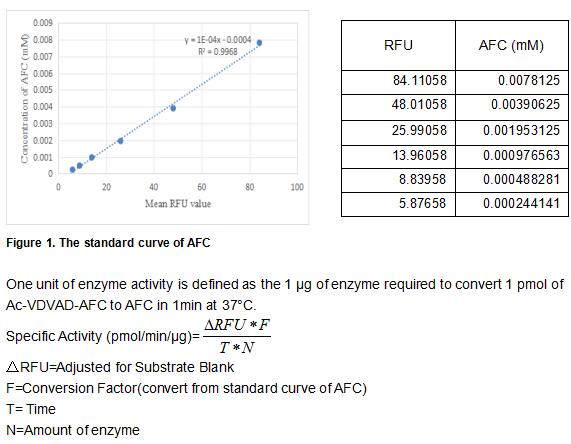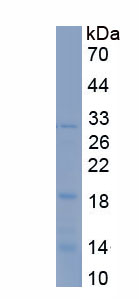Active Caspase 2 (CASP2) 

ICH1L; NEDD2; ICH-1L/1S; Cysteinyl Aspartate Specific Proteinases 2; Apoptosis-Related Cysteine Peptidase; Neural Precursor Cell Expressed Developmentally Down-Regulated 2
- UOM
- FOB US$ 300.00 US$ 750.00 US$ 1,500.00 US$ 4,500.00 US$ 11,250.00
- Quantity
Overview
Properties
- Product No.APA244Hu04
- Organism SpeciesHomo sapiens (Human) Same name, Different species.
- ApplicationsCell culture; Activity Assays.
Research use only - DownloadInstruction Manual
- CategoryApoptosis
- Buffer FormulationPBS, pH7.4, containing 0.01% SKL, 5% Trehalose.
- Traits Freeze-dried powder, Purity > 80%
- Isoelectric Point6.9
Sign into your account
Share a new citation as an author
Upload your experimental result
Review

Contact us
Please fill in the blank.
Activity test

Caspase-2 (CASP2) is a 30 32 kDa member of the peptidase C14A/IL 1 beta-converting family of enzymes. It is widely expressed and is an integral component of the apoptotic cascade. Based on the length of its prodomain, caspase-2 has been considered to be an initiator caspase. Human procaspase-2 is a 48 51 kDa, 452 amino acid (aa) protein. It is known to exist as a disulfide-linked homodimer via covalent linkage at Cys436. But this dimeric state may not be sufficient for (auto) activation. Actual activation may occur following oligomerization within the context of activating platforms such as DISC (death-inducing signaling complex) or the PIDDosome. The activity assay of recombinant human CASP2 was measured by its ability to cleave the fluorogenic peptide substrate Ac-VDVAD-AFC. The reaction was performed in 25 mM HEPES, 0.1% (w/v) CHAPS, 10 mM dithiothreitol (DTT), pH 7.5 ( Assay Buffer). The CASP2 was diluted to 3 ug/ml by assay buffer and incubated at room temperature for 15min. The reaction was initiated by adding 50 ul 3 ug/ml CASP2 to 50 ul of 200 uM substrate and then read at excitation and emission wavelengths of 400 nm and 505 nm (top read), respectively, in kinetic mode for 5 minutes. The specific activity of recombinant human CASP2 is 2100 pmol/min/µg.
Usage
Reconstitute in ddH2O to a concentration of 0.1-0.3 mg/mL. Do not vortex.
Storage
Avoid repeated freeze/thaw cycles. Store at 2-8°C for one month. Aliquot and store at -80°C for 12 months.
Stability
The thermal stability is described by the loss rate. The loss rate was determined by accelerated thermal degradation test, that is, incubate the protein at 37°C for 48h, and no obvious degradation and precipitation were observed. The loss rate is less than 5% within the expiration date under appropriate storage condition.
Increment services
-
 BCA Protein Quantification Kit
BCA Protein Quantification Kit
-
 Molecular Mass Marker for Protein
Molecular Mass Marker for Protein
-
 Monoclonal Antibody Customized Service
Monoclonal Antibody Customized Service
-
 Polyclonal Antibody Customized Service
Polyclonal Antibody Customized Service
-
 Protein Activity Test Experiment Service
Protein Activity Test Experiment Service
-
 Electrophoretic Mobility Shift Assay (EMSA) Experiment Service
Electrophoretic Mobility Shift Assay (EMSA) Experiment Service
-
 Buffer
Buffer
-
 Lentivirus Packaging Experiment Service
Lentivirus Packaging Experiment Service
-
 Adenovirus Packaging Experiment Service
Adenovirus Packaging Experiment Service
-
 Real Time PCR Experimental Service
Real Time PCR Experimental Service
-
 Spike RBD Protein (S-RBD)
Spike RBD Protein (S-RBD)
-
 Protein G
Protein G
-
 Protein A
Protein A







